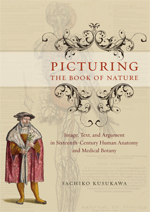
S. Kusukama, Picturing the Book of Nature : Image, Text, and Argument in Sixteenth-Century Human Anatomy and Medical Botany,
Sachiko KUSUKAWA, Picturing the Book of Nature : Image, Text, and Argument in Sixteenth-Century Human Anatomy and Medical Botany, Chicago, The University of Chicago Press, 2012, 304 p.
Because of their spectacular, naturalistic pictures of plants and the human body, Leonhart Fuchs’s De historia stirpium and Andreas Vesalius’s De humani corporis fabrica are landmark publications in the history of the printed book. But as Picturing the Book of Nature makes clear, they do more than bear witness to the development of book publishing during the Renaissance and to the prominence attained by the fields of medical botany and anatomy in European medicine. Sachiko Kusukawa examines these texts, as well as Conrad Gessner’s unpublished Historia plantarum, and demonstrates how their illustrations were integral to the emergence of a new type of argument during this period—a visual argument for the scientific study of nature.
To set the stage, Kusukawa begins with a survey of the technical, financial, artistic, and political conditions that governed the production of printed books during the Renaissance. It was during the first half of the sixteenth century that learned authors began using images in their research and writing, but because the technology was so new, there was a great deal of variety of thought—and often disagreement—about exactly what images could do: how they should be used, what degree of authority should be attributed to them, which graphic elements were bearers of that authority, and what sorts of truths images could and did encode. Kusukawa investigates the works of Fuchs, Gessner, and Vesalius in light of these debates, scrutinizing the scientists’ treatment of illustrations and tracing their motivation for including them in their works. What results is a fascinating and original study of the visual dimension of scientific knowledge in the sixteenth century.
Introduction
Part 1. Printing pictures
Chapter 1. Techniques and Craftsmen
Chapter 2. Publishers’ Calculations
Chapter 3. Copying and Coloring
Chapter 4. Control
Part 2. Picturing Medicinal Plants
Chapter 5. Accidents and Arguments: Fuchs’s De Historia Stirpium
Chapter 6. Arguments over Pictures: Reactions to Fuchs’s De Historia Stirpium
Chapter 7. Gessner and the Making of the Historia Plantarum
Chapter 8. The Authority of Pictures: Gessner, Mattioli, and Jamnitzer
Part 3. Picturing Human Anatomy
Chapter 9. Vesalius and the Bloodletting Controversy
Chapter 10. The Canon of the Human Body: Vesalius’s De Humani Corporis Fabrica
Chapter 11. Text, Image, Body, and the Book
Epilogue
Bibliography
Index
* * *
On peut lire sur le site laviedesidees.fr un article sur cet ouvrage:
"Ceci n'est pas un beau livre", par P.-Y. Lacour.
"L'ouvrage de S. Kusukawa analyse la première élaboration d’un régime propre à l’image scientifique dans les savoirs d’observation, en botanique et en anatomie notamment. Il montre comment ce nouveau régime de l’image s’avère capital dans la genèse des sciences modernes.l’ouvrage de S. Kusukawa analyse la première élaboration d’un régime propre à l’image scientifique dans les savoirs d’observation, en botanique et en anatomie notamment. Il montre comment ce nouveau régime de l’image s’avère capital dans la genèse des sciences modernes."